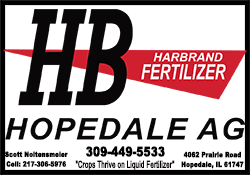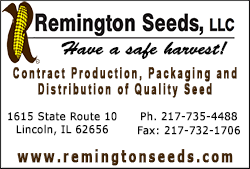|
 Our vocabulary is also
increasing almost daily. We still have the covid virus with us, and
the numerous variants with it. “Supply chain issues” has become one
of those phrases which has been born out of the pandemic. Lay the
blame on the supply, or the delivery, but the end result is a lack
of products available for purchase, or the lack of goods to purchase
at a reasonable price. Sure, the crop prices have risen
dramatically, but so have expenses. The U of I crop budget updates
for 2022, from Gary Schnitkey, show $1090 in total income for corn
per acre, with non-land costs of $770. This would leave $320 per
acre for land costs and operator profit. Take the land cost out, and
there isn’t much left for the operator profit – if anything.
Soybeans look slightly better with $376 for land cost and operator
profit. Fertilizer, pesticides, and seed make up well over half the
cost of producing the crop for both corn and soybeans. Our vocabulary is also
increasing almost daily. We still have the covid virus with us, and
the numerous variants with it. “Supply chain issues” has become one
of those phrases which has been born out of the pandemic. Lay the
blame on the supply, or the delivery, but the end result is a lack
of products available for purchase, or the lack of goods to purchase
at a reasonable price. Sure, the crop prices have risen
dramatically, but so have expenses. The U of I crop budget updates
for 2022, from Gary Schnitkey, show $1090 in total income for corn
per acre, with non-land costs of $770. This would leave $320 per
acre for land costs and operator profit. Take the land cost out, and
there isn’t much left for the operator profit – if anything.
Soybeans look slightly better with $376 for land cost and operator
profit. Fertilizer, pesticides, and seed make up well over half the
cost of producing the crop for both corn and soybeans.
With the increase in crop prices, there has been a runup in both
land costs and in the associated rents. Another contributing factor
would definitely be the lack of return on other investments such as
CD’s, and this factor tends to bring in investor money to purchase
farmland. Land values, and cash rents, typically trail the economic
climate in agriculture by a year. This means the current prices for
land and rent are more based on last year’s income potential than
the current year.

Technology remains one of the driving forces in agriculture. As an
industry, we continue to substitute technology and machinery for
labor. Improvements in efficiency continue to drive the increase in
size of many farming operations. We continue to increase the size
and capability of our equipment. Newer trends include more crop
scouting technologies such as fertilizer application based on foliar
analysis, increased use of drones in scouting applications, and
sensors used in herbicide applications. As technology in equipment
has increased, and the labor market has grown exceptionally tight,
the availability of certain farm equipment has become very tight.
Many advanced machines are a year out on an order basis. This is
very similar to the auto market, but on a much costlier basis.
Most producers are always looking for a way to increase efficiency.
One of the methods to do this is to contract things out. In this
case, many of the local suppliers are providing some of the labor
for the farming operation. Of course, this also helps the supplier
bottom line. Common examples go from simple things like delivering
products, to the application of products such as herbicides.
Increasingly there are more items such as custom ammonia
application, soil sampling, and crop scouting. In reality, this is a
way for a group of producers to share the labor of an experienced
person.
[to top of second column] |

As we look to the coming year,
there are many questions. The seasonal outlooks from the National
Weather Service have our area in a “leaning above average” area for
temperatures. We are also on the edge of one of the only areas in
the country to have “leaning above average” for moisture. Timely
planting is the first part of being on the way to a good crop.
Preferred planting times are now in April for both corn and
soybeans, and timely planting is the first step toward a good yield
in the fall.

The cost, and supply, of inputs we depend on is very unpredictable
at this point. Everyone is hopeful these issues will be resolved,
but most are planning on disruptions and higher costs. The farming
community will probably once again have to prove their
resourcefulness and adaptability. We all look forward to having a
safe and productive spring season.
 |